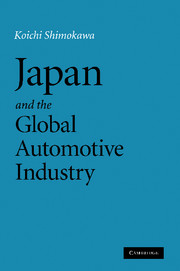Book contents
- Frontmatter
- Contents
- List of figures
- List of tables
- Preface
- Introduction
- 1 Comparing productivity of the Japanese and US automobile industries
- 2 The internationalization of the Japanese automotive industry and local production overseas
- 3 The recovery of European and US auto makers, and relocating and changing lean production
- 4 Early 1990s – the Japanese automotive industry loses international competitiveness, and the development of restructuring strategies
- 5 The restructuring of the global automotive and auto-parts industries
- 6 The restructuring of the world's auto-parts industry and the transfiguration of the keiretsu parts transaction
- 7 Global M&A and the future of the global auto industry – the light and dark sides of merger and re-alignment
- 8 The Asian and ASEAN automotive industries in the global era
- 9 China's automotive industry in the global era, Japanese auto makers, and their China strategies
- 10 Conclusion – the global automotive industry's perspective on the twenty-first century and tasks for the Japanese automotive industry
- Epilogue
- Index
- References
3 - The recovery of European and US auto makers, and relocating and changing lean production
Published online by Cambridge University Press: 06 July 2010
- Frontmatter
- Contents
- List of figures
- List of tables
- Preface
- Introduction
- 1 Comparing productivity of the Japanese and US automobile industries
- 2 The internationalization of the Japanese automotive industry and local production overseas
- 3 The recovery of European and US auto makers, and relocating and changing lean production
- 4 Early 1990s – the Japanese automotive industry loses international competitiveness, and the development of restructuring strategies
- 5 The restructuring of the global automotive and auto-parts industries
- 6 The restructuring of the world's auto-parts industry and the transfiguration of the keiretsu parts transaction
- 7 Global M&A and the future of the global auto industry – the light and dark sides of merger and re-alignment
- 8 The Asian and ASEAN automotive industries in the global era
- 9 China's automotive industry in the global era, Japanese auto makers, and their China strategies
- 10 Conclusion – the global automotive industry's perspective on the twenty-first century and tasks for the Japanese automotive industry
- Epilogue
- Index
- References
Summary
Introduction
As we have witnessed, the competitive relationship between the Japanese and Western automobile industries has experienced a dramatic transformation in the age of globalization and worldwide restructuring. In the 1980s, the Japanese automobile industry led the world with its lean production system, which was implemented at local plants in Europe as well as in the United States. All three major differentiating factors – just-in-time production systems and total quality control (TQC) activities, the keiretsu supplier system, and a product development system based on simultaneous engineering with a short lead time – functioned together to create the Japanese automobile industry's competitive strength. While Japanese companies introduced these systems in their overseas plants, Western auto manufacturers applied themselves to learning the system. This chapter investigates the transformation that took place, and considers the lessons to be learned in the context of a new management paradigm for the automobile industry in a global era.
Rapid learning of lean production by European and US automobile makers
The basic Japanese production system
European and US automobile makers recovered their competitiveness and learned the Japanese production system extremely quickly, partly because they conducted a thorough systematic analysis of the Japanese systems and shared information. Though some of the reforms to their factories were not satisfactory, various, more successful reforms were conducted in other areas.
The US auto makers were already looking at the structural factors for Japan's competitiveness in the mid 1980s, and began working toward improvement at the public and private levels.
- Type
- Chapter
- Information
- Japan and the Global Automotive Industry , pp. 83 - 91Publisher: Cambridge University PressPrint publication year: 2010

